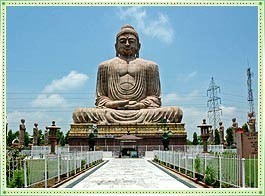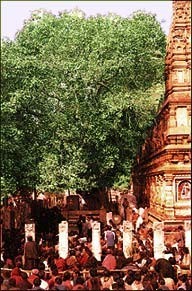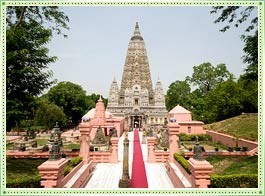
Bodh Gaya or Bodhgaya is a religious place in Gaya district in the Indian state of Bihar. It is famous for being the place of Gautama Buddha’s attainment of Enlightenment.
Historically, it was known as the Bodhimanda (ground around the Bodhi-tree), Uruvela, Sambodhi, Vajrasana and Mahabodhi.
(1) The name Bodh Gaya did not come into use until the 18th century. The main monastery of Bodhgaya used to be called the Bodhimanda-
For Buddhists, Bodh Gaya is the most important of the main four pilgrimage sites related to the life of Gautama Buddha, the other three being Kushinagar, Lumbini, and Sarnath. In 2002, Mahabodhi Temple, located in Bodh Gaya, became a UNESCO World Heritage Site.
(2) The surrounding town, by contrast, is dusty, noisy and somewhat polluted, due in large part to a lack of proper administrative structural coordination and rampant local corruption.
(3) A new development plan has been proposed to “ensure a sustainable and prosperous future” for Bodh
Bodh Gaya is the place where Gautam Buddha attained enlightenment under the sacred Asvatta tree (later termed Bodhi Tree). Buddhists all across the world consider the place the most sacred and this has become a pilgrim destination for them. Buddhists from all over the world have built temples here in Bodh Gaya. Bodh Gaya
Bodh Gaya houses a splendid and magnificent Mahabodhi temple and the temple has Bodhi Tree. Both the temple and the Bodhi Tree are sacred for Buddhists across the globe. The temple is an architectural amalgamation of many centuries, cultures, and
In the year 1953, Bodh Gaya revisited its glory. A new stupa with the help of Japanese governments’ donation was built in Gaya. Buddhists from Sri Lanka, Thailand, Myanmar, Bhutan, Korea, and Japan often visit
How to Reach Bodh Gaya:
Bodh Gaya is included in four most important pilgrim destinations where a Buddhist has to visit in
By Rail:
A good railway network connects Bodh Gaya with other major cities of India. A whole range of trains is available to reach Bodh Gaya. Gaya is the nearest railhead to Bodh Gaya at the distance of 17
By Road:
Besides a good network or railway tracks, Bodh Gaya is well connected by roads to various cities of India. The main bus stand is near Sujata Bridge on the bank of Falgu River on the northeastern edge of the town. Gaya is the nearest transport hub which is connected with Grand Trunk Road and from where you can catch direct
By Air:
Gaya is the nearest airport from Bodh Gaya. It is located at a distance of 17
Bodh Gaya Tourist Attractions:
Bodh Gaya, being the place where Gautam Buddha had learnt the eternal truth, is a popular tourist destination among Buddhists across the globe. There are a number of Buddhist monuments, temples and monasteries to see in Bodh Gaya.

Bodhi Tree
Contrary to general belief the existing Bodhi Tree is not the original Bodhi Tree under which
Gurpa
Gurpa is located forty
Mahabodhi Temple
The fifty meter high Mahabodhi Temple was built during the rule of the Guptas in the 5th century. This temple is considered among the oldest in Indian sub-continent temples.

Pragbodhi
Pragbodhi is the place where Lord Buddha spent some time before attaining enlightenment. The place is evidence of Gautam Buddha’s efforts toward the eternal truth.
Bodh Gaya Weather:
The city of Bodh Gaya is located at an altitude of 24º 41′ 45” N. Latitude and 85º 2′ 22” E. Longitude. Let’s have a quick look at the weather and climatic conditions of Bodh Gaya.